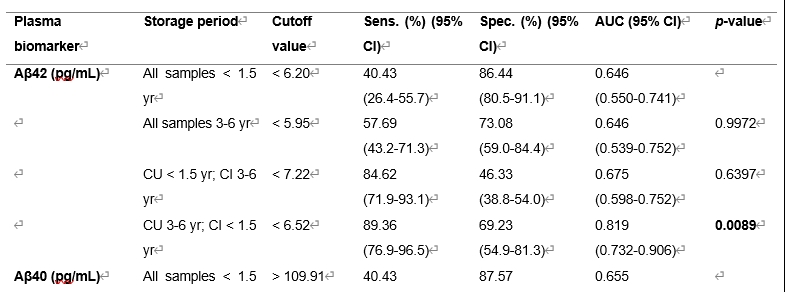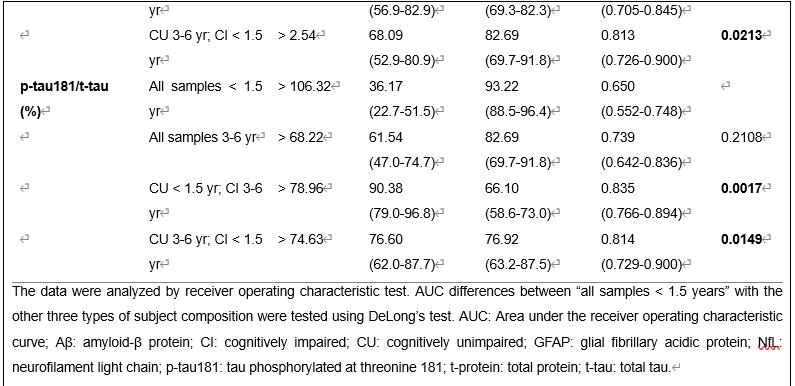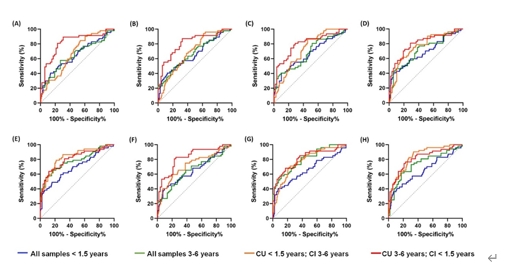NRR:首都医科大学宣武医院蔡燕宁团队提出神经退行性疾病生物标志物队列研究要考虑样本储存时间的影响
撰文:赵立芳
近年来,神经退行性疾病的外周血生物标志物的研究发展迅速,可能在不久的将来彻底改变阿尔茨海默病等疾病的诊疗现状。现实中,临床队列研究往往需要纳入成千上万的受试者,如此庞大的外周血样本量的采集时间可能达到几年甚至十几年;另外临床的纵向队列或回顾性队列研究也涉及到同一批患者不同时间收取的样本的比较,也会用到存储几年或者十几年的样本[1-9]。然而,这些长期存储的外周血样本中的生物标志物的浓度是否稳定却极少得到关注。探索存储时间对生物标志物的稳定性及其诊断效能的影响,可以更好的改进存储方式,解决慢病研究所面临的样本存储问题,为生物标志物的临床应用奠定前期基础。
中国首都医科大学宣武医院蔡燕宁团队在《中国神经再生研究(英文)》(Neural Regeneration Research)上发表了题为“Storage time affects the level and diagnostic efficacy of plasma biomarkers for neurodegenerative diseases”的研究,发现血浆中的神经退行性疾病生物标志物淀粉样蛋白β(amyloid-β,Aβ)、神经丝轻链蛋白(neurofilament light chain,NfL)和胶质纤维酸性蛋白(glial fibrillary acidic protein,GFAP)浓度比较稳定,而总tau(total tau,t-tau)蛋白的浓度则出现随存储时间延长的下降趋势。进一步分析发现,在认知正常人群中,血浆总蛋白浓度(total protein,t-protein)和磷酸化tau181(phosphorylated tau 181,p-tau181)的浓度也随着存储时间延长出现下降趋势;而该趋势在认知受损人群中没有出现,这一情况可能导致p-tau181和p-tau181/t-tau的诊断效能在不同队列中出现明显变化。该文带来的启示:外周血生物标志物研究中应充分考虑存储时间这一变量带来的影响。赵立芳和张铭凯为论文共同第一作者,蔡燕宁教授、韩璎教授和卢洁教授为论文共同通讯作者。
大量临床队列研究使用在-80℃存储的血浆样本进行生物标志物的检测,存储时间对生物标志物浓度的影响尚未得到充分研究[10-14]。蔡燕宁等纳入328例参与者(229例认知正常;99例认知受损)的血浆样本,这些样本的存储时间均匀分布于1个月至6年。采用单分子阵列(single molecule array,Simoa)免疫检测法分析这些血浆样本中神经退行性疾病生物标志物的浓度,结果显示,Aβ42、Aβ40、NfL和GFAP的浓度与存储时间没有显著相关性,而t-tau浓度与存储时间呈显著负相关关系(表1)。进一步分组分析发现,在认知正常组里,t-protein和p-tau181的浓度与存储时间呈负相关,这一现象未出现在认知受损人群(表2和图1)。此次研究证实了80℃长期存储的外周血样本中生物标志物的稳定性确实会发生改变,对科学研究和临床实践产生负面影响。
表1 神经退行性疾病生物标志物浓度与血浆样本存储时间的相关性(表源:Zhao et al., Neural Regen Res, 2025)

表2 血浆样本存储时间对神经退行性疾病生物标志物在诊断疾病过程中的敏感性、特异性和准确性的影响(表源:Zhao et al., Neural Regen Res, 2025)



图1 神经退行性疾病生物标志物在不同队列中区分患者的受试者特征曲线(图源:Zhao et al., Neural Regen Res, 2025)

综上,长期存储可对神经退行性疾病生物标志物的浓度产生影响。蔡燕宁等研究表明,外周血样本的存储时间会对生物标志物的浓度和诊断效能带来不同的影响,因此在队列研究中要充分考虑存储时间这一变量对分析的影响。该研究将为后续外周血样本的存储策略的制定提供基础。
研究也存在一定的局限性。首先,该研究中样本的存储时间最长6年,没有展示更长存储时间对样本中生物标志物的影响;其次,该队列只有328人,且疾病分布不均衡(认知正常人群229人,认知受损为99人),导致结果可能受到一定影响;再次,未纳入其他几种磷酸化tau的标志物(如p-tau217和p-tau231)的分析。故此,未来的研究应纳入更多各因素更均衡的入组对象,进行更多生物标志物的检测;同时,改进的存储策略也应该是将来的研究重点。
原文链接:https://doi.org/10.4103/NRR.NRR-D-23-01983
参考文献
[1] Ferreira PCL, Zhang Y, Snitz B, et al. Plasma biomarkers identify older adults at risk of Alzheimer's disease and related dementias in a real-world population-based cohort. Alzheimers Dement. 2023;19(10):4507-4519.
[2] Janelidze S, Mattsson N, Palmqvist S, et al. Plasma P-tau181 in Alzheimer's disease: relationship to other biomarkers, differential diagnosis, neuropathology and longitudinal progression to Alzheimer's dementia. Nat Med. 2020;26(3):379-386.
[3] Kornhuber J, Schmidtke K, Frolich L, et al. Early and differential diagnosis of dementia and mild cognitive impairment: design and cohort baseline characteristics of the German Dementia Competence Network. Dement Geriatr Cogn Disord. 2009;27(5):404-417.
[4] Mattsson-Carlgren N, Janelidze S, Palmqvist S, et al. Longitudinal plasma p-tau217 is increased in early stages of Alzheimer's disease. Brain. 2020;143(11):3234-3241.
[5] Meyer PF, Ashton NJ, Karikari TK, et al. Plasma p-tau231, p-tau181, PET Biomarkers, and Cognitive Change in Older Adults. Ann Neurol. 2022;91(4):548-560.
[6] Mielke MM, Hagen CE, Xu J, et al. Plasma phospho-tau181 increases with Alzheimer's disease clinical severity and is associated with tau- and amyloid-positron emission tomography. Alzheimers Dement. 2018;14(8):989-997.
[7] Mueller SG, Weiner MW, Thal LJ, et al. Ways toward an early diagnosis in Alzheimer's disease: the Alzheimer's Disease Neuroimaging Initiative (ADNI). Alzheimers Dement. 2005;1(1):55-66.
[8] Rajan KB, Aggarwal NT, Mcaninch EA, et al. Remote blood biomarkers of longitudinal cognitive outcomes in a population study. Ann Neurol. 2020;88(6):1065-1076.
[9] Visser PJ, Verhey FR, Boada M, et al. Development of screening guidelines and clinical criteria for predementia Alzheimer's disease. The DESCRIPA Study. Neuroepidemiology. 2008;30(4):254-265.
[10] Chiu MJ, Lue LF, Sabbagh MN, et al. Long-term storage effects on stability of Aβ(1-40), Aβ(1-42), and total tau proteins in human plasma samples measured with immunomagnetic reduction assays. Dement Geriatr Cogn Dis Extra. 2019;9(1):77-86.
[11] Enroth S, Hallmans G, Grankvist K, et al. Effects of long-term storage time and original sampling month on biobank plasma protein concentrations. EBioMedicine. 2016;12:309-314.
[12] Morgan AR, O'hagan C, Touchard S, et al. Effects of freezer storage time on levels of complement biomarkers. BMC Res Notes. 2017;10(1):559.
[13] Schubert CR, Paulsen AJ, Pinto AA, et al. Effect of long-term storage on the reliability of blood biomarkers for Alzheimer's disease and neurodegeneration. J Alzheimers Dis. 2022;85(3):1021-1029.
[14] Van Der Horn HJ, Visser K, Bijzet J, et al. Long-term stability of blood serum biomarkers in traumatic brain injury: a feasibility study. Front Neurol. 2022;13:877050.




